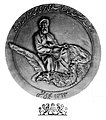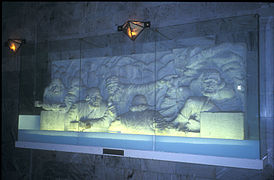Tomb of Ferdowsi
| Tomb of Ferdowsi | |
|---|---|
آرامگاه فردوسی | |
 | |
 | |
| General information | |
| Architectural style | Iranian architecture |
| Town or city | Tus, Mashhad |
| Country | Iran |
| Completed | 1934 |
| Design and construction | |
| Architect(s) | Hooshang Seyhoun |
The Tomb of Ferdowsi (Persian: آرامگاه فردوسی, Ârâmgâh-e Ferdowsi) is a tomb complex composed of a white marble base, and a decorative edifice erected in honor of the Persian poet Ferdowsi located in Tus, Iran, in Razavi Khorasan province. It was built in the early 1930s,[1] under the regime of Reza Shah, and uses mainly elements of Achaemenid architecture to demonstrate Iran's rich culture and history. The construction of the mausoleum as well as its aesthetic design is a reflection of the cultural, and geo-political status of Iran at the time.
Background


It was not until 1934 that the Iranian government, then under the control of
The tomb was originally designed by the Iranian architect, Haj Hossein Lurzadeh who aside from Ferdowsi's tomb also created some 842 mosques, as well as the private palace of Ramsar, part of the decoration of the Marmar palace, the Imam Hossein Mosque in Tehran, the Motahari Mosque, and various parts of the Hazrat-i-Seyyed-o-Shouhada shrine in Karbala, Iraq.[5] The present design of the structure is credited mainly to Karim Taherzadeh, who replaced the old dome-shaped design by Lurzadeh with a modern cubical design.[6]
Ferdowsi's tomb, which resembles the
-
Tomb of Ferdowsi around 1930s, by André Godard and Teymoortash.
-
3rd architecture design of Ferdowsi mausoleum, by Taherzade Behzad
-
One of the first tickets sold for theFerdowsi millenaryclearly shows the layering structure of the tomb.
-
Ferdowsi's tomb, Tus, Iran
-
Ferdowsi millennial celebration commemorative medal
Structural details
The basic structure of the tomb is rectangular with a large garden surrounding the structure and interacting with the structure in the Persian style of gardening known as Char-bagh (or Chaharbagh translating to four gardens in Persian). In the center of the cross created by the legs of the garden surrounding it, is an edifice made of primarily white marble. The edifice can be divided into a "wide chamber" that lies at the base and a cubical erection on top, with four pillars surrounding it and scenes from the epic of Shahnameh and text ornating it. The body of the poet is actually interred in the center of the rectangular wide chamber underneath the overlying four pillars cube.[3] There are twelve (12) steps leading from the lowest point of the wide chamber all the way to the level of the cube. The wide base has a total height of 16 m. The edifice has equal dimensions of 30 m on each side.
The following are schematic diagrams of the aerial view of the tomb's wide base and edifice section and their topography:
A unique feature of the design of Ferdowsi's tomb has been its resemblance to that of Cyrus the Great in
-
A well-preserved column in Persepolis. Note the two bulls and the ornations.
-
The aerial and the profile view of the edifice as it sits atop the wide base
-
Front façade of the edifice of Ferdowsi's mausoleum; Note the columns and the two bulls.
-
Photo from Persepolis showing Faravahar and also note the flower decoration. Similar if not exact flower decoration is used in Ferdowsi's tomb.
-
National Bank of Iran in 1946 with the Faravahar symbol on the top.
-
Perspolisic Abstract Patterns of Persian column - Ferdowsi tomb interior
-
Decorative patterns, detail from the griffins' frieze in Darius' palace at Susa. Glazed siliceous bricks, ca. 510 BC.
-
A profile view of the edifice depicting the Faravahar symbol as well as Persian poetry etched in the door panels.
-
The aerial and the profile view of the rectangular "wide base" of the tomb.
-
This repeated hexagonal pattern is utilized to ornate the floor of the "wide base".
-
Pond and fountains of Ferdowsi mausoleum and Toos Razavi hospital.
-
two another buildings of Ferdowsi mausoleum
-
two another buildings of Ferdowsi mausoleum
A closer look at the edifice points out that there are four columns each at the corner of the rectangular structure with two half-buried columns that protrude as deep
Comparison of the Persepolis columns, and the columns used in Ferdowsi's mausoleum:
Historical context
Ferdowsi lived his life as a poor man constantly moving from court to court, and eventually died a poor widower, having lost his only son.
In the time frame preceding the construction of the mausoleum, nationalistic feelings in Iran were high.
We supported Reza Shah, and we wanted to support his effort to create a modern nation state, to lift us from our backwardness. At this time we talked about Pan-Iraniasm, or reuniting Afghanistan with Iran. We also talked of nationalism. Ferdowsi became very popular partly because of Reza Shah's support for him, and also partly because of the nationalistic impulses the shahnameh inspired.[12]
The architecture of Ferdowsi's tomb is also influenced by poet's own personal life, reflecting a constant struggle between the poor poet and the lazy king, and adversity and hope. The Society for National Heritage in 1930s drawing on poet's attempt to revitalize the Persian language, also attempted to revitalize Persian culture and Iranian identity through architecture.[13] This was in many ways taken literally with Persian poems from Shahnameh etched into the white marble facets of the edifice of the poet's mausoleum.
After the Iranian revolution, both tomb of Ferdowsi and even mausoleum of Cyrus the Great survived the initial chaos. One of the most dangerous threats to the structure was that it would be equated with the late Pahlavi dynasty by the new regime and destroyed. It however was not and was instead embraced by the new local government since Ferdowsi was a devout
-
A damaged sculpture of Ferdowsi tomb, by Fereydoon Seddeghi.
Interior design

Ferdowsi's Shahnameh inspires tales of heroic act by

The Persian inscription on the tomb:
بنام خداوند جان و خرد. این مکان فرخنده آرامگاه استاد گویندگان فارسیزبان و سراینده داستانهای ملی ایران، حکیم ابوالقاسم فردوسی طوسی است که سخنان او زندهکننده کشور ایران و مزار او در دل مردم این سرزمین جاودان است. تاریخ تولّد: ۳۲۹ هجری قمری – تاریخ وفات: ۴۱۱ هجری قمری – تاریخ بنای آرامگاه: ۱۳۵۳ هجری قمری
A free English translation:
In the name of the god of life and wisdom. This place is the resting place of he (Hakim Abul-qasem Ferdowsi Tusi) who has advanced the art of language among Persian speakers, and the holder of the national epic of Iran and its national stories. His words have given a new life to Iran, and he has a place in the hearts of its people...
A more exact English translation:
In the name of the God of life and wisdom. This auspicious place is the resting place of the master of the speakers of the Persian tongue and the author of Iranian national stories, sage Abul-Qasem Ferdowsi Tusi whose utterances are imbuing the country of Iran with new live, and whose tomb lives eternally in the hearts of the people of this land. Date of birth: 329 of the lunar hijra - date of death: 411 of the lunar hijra - the date the mausoleum was erected: 1353 of the lunar hijra [translated by Ivonna Nowicka].
-
A frieze sculpture scene inside of the tomb depicting the mystical bird simurgh and the hero
-
Another frieze scene, this one depicting a scene from Shahnameh.
Legacy
Today Ferdowsi's tomb is one of the most photographed in Iran.
References
- ^ a b c A. Shahpur, Shahbazi (Dec 15, 1999). "Ferdowsi, Abul-qasem. Mausoleum". Encyclopedia Iranica. Columbia University. Retrieved 27 March 2014.
- ISBN 9781137001283.
- ^ ISBN 9781477202913.
- ISBN 9780306819018.
- ^ ISBN 9789649449142.
- ISBN 9780295800615.
- ^ ISBN 9781135125530.
- ISBN 9781136398490.
- ^ James Fergusson (1851). The palaces of Nineveh and Persepolis restored: an essay on ancient Assyrian and Persian architecture, Volume 5. J. Murray. pp. 214–216 & 206–209 (Zoroaster Cube: pp. 206).
- ^ "Ferdowsi Tomb, Toos-Khorasan-Iran". Where is Iran. Retrieved March 27, 2014.
- ISBN 9780786731985.
- ^ ISBN 9780393078756.
- ISBN 9780761827467.
- ISBN 9780393051193.
ferdowsi devout muslim.
- ^ "Iraqi tourism minister visits tomb of Ferdowsi". IRNA. IRNA. 25 July 2013. Retrieved March 27, 2014.



































